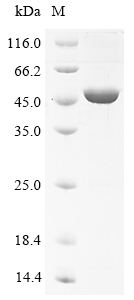The expression region of this recombinant Mouse Nptx1 covers amino acids 23-432. The theoretical molecular weight of the Nptx1 protein is 49.1 kDa. This Nptx1 recombinant protein is manufactured in e.coli. The Nptx1 coding gene included the N-terminal 6xHis tag, which simplifies the detection and purification processes of the recombinant Nptx1 protein in following stages of expression and purification.
The mouse neuronal Pentraxin-1 (Nptx1) is a member of the pentraxin family of proteins primarily expressed in the central nervous system, particularly in neurons. Nptx1 is involved in synaptic plasticity and is known to play a role in the modulation of excitatory synapses. It interacts with the neuronal pentraxin receptor (NPTXR), influencing the development and maintenance of excitatory synapses. Nptx1 has been implicated in various neurological processes, including learning and memory. Its ability to regulate synaptic function suggests its significance in neuronal communication and network activity. Understanding the functions of Nptx1 can provide insights into the molecular mechanisms underlying synaptic plasticity and contribute to the knowledge of neurodevelopmental and neurodegenerative disorders.






